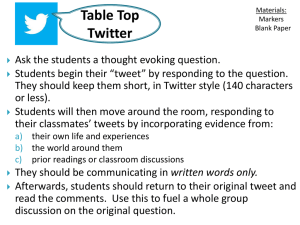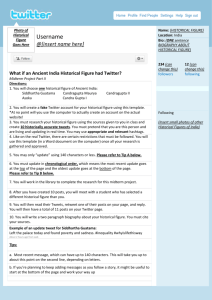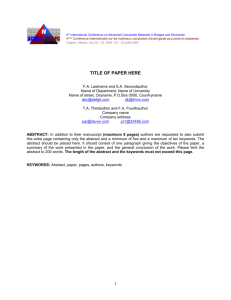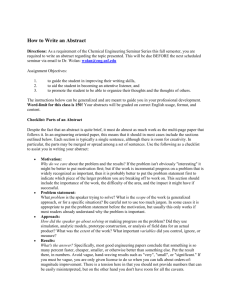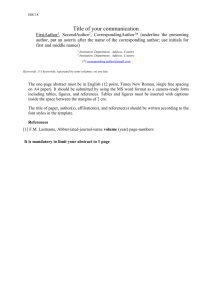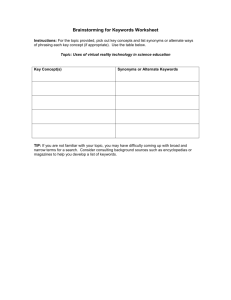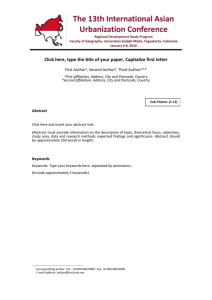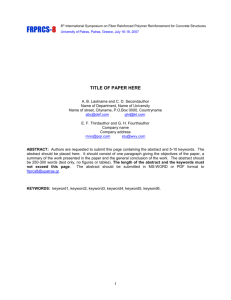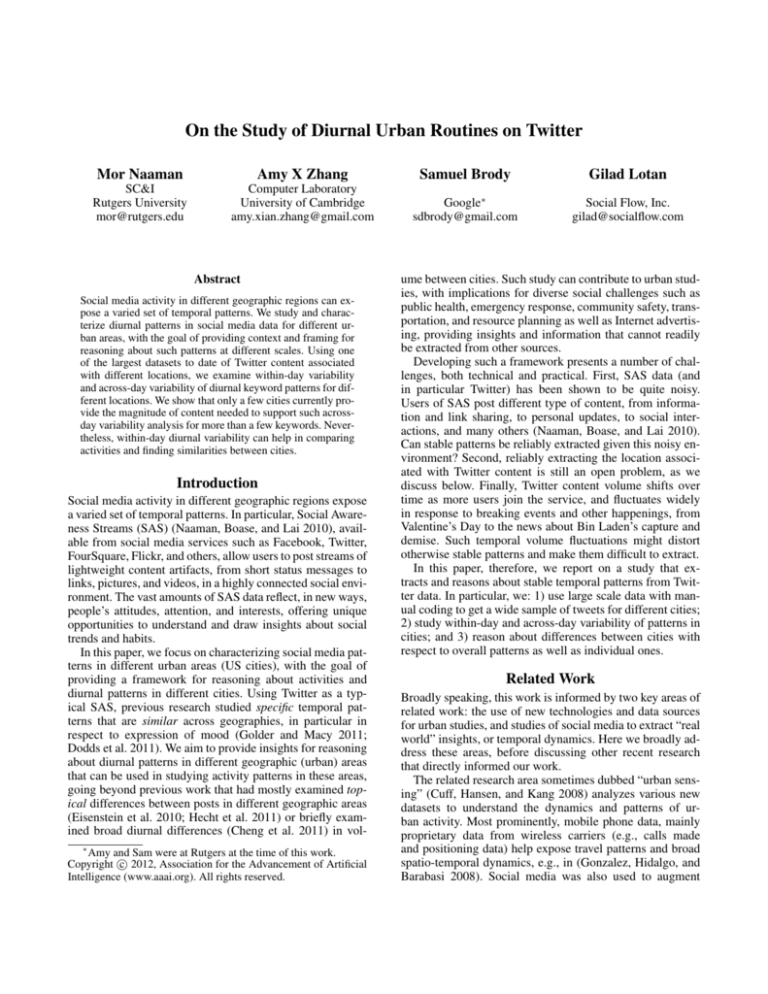
On the Study of Diurnal Urban Routines on Twitter
Mor Naaman
Amy X Zhang
Samuel Brody
Gilad Lotan
SC&I
Rutgers University
mor@rutgers.edu
Computer Laboratory
University of Cambridge
amy.xian.zhang@gmail.com
Google∗
sdbrody@gmail.com
Social Flow, Inc.
gilad@socialflow.com
Abstract
Social media activity in different geographic regions can expose a varied set of temporal patterns. We study and characterize diurnal patterns in social media data for different urban areas, with the goal of providing context and framing for
reasoning about such patterns at different scales. Using one
of the largest datasets to date of Twitter content associated
with different locations, we examine within-day variability
and across-day variability of diurnal keyword patterns for different locations. We show that only a few cities currently provide the magnitude of content needed to support such acrossday variability analysis for more than a few keywords. Nevertheless, within-day diurnal variability can help in comparing
activities and finding similarities between cities.
Introduction
Social media activity in different geographic regions expose
a varied set of temporal patterns. In particular, Social Awareness Streams (SAS) (Naaman, Boase, and Lai 2010), available from social media services such as Facebook, Twitter,
FourSquare, Flickr, and others, allow users to post streams of
lightweight content artifacts, from short status messages to
links, pictures, and videos, in a highly connected social environment. The vast amounts of SAS data reflect, in new ways,
people’s attitudes, attention, and interests, offering unique
opportunities to understand and draw insights about social
trends and habits.
In this paper, we focus on characterizing social media patterns in different urban areas (US cities), with the goal of
providing a framework for reasoning about activities and
diurnal patterns in different cities. Using Twitter as a typical SAS, previous research studied specific temporal patterns that are similar across geographies, in particular in
respect to expression of mood (Golder and Macy 2011;
Dodds et al. 2011). We aim to provide insights for reasoning
about diurnal patterns in different geographic (urban) areas
that can be used in studying activity patterns in these areas,
going beyond previous work that had mostly examined topical differences between posts in different geographic areas
(Eisenstein et al. 2010; Hecht et al. 2011) or briefly examined broad diurnal differences (Cheng et al. 2011) in vol∗
Amy and Sam were at Rutgers at the time of this work.
c 2012, Association for the Advancement of Artificial
Copyright Intelligence (www.aaai.org). All rights reserved.
ume between cities. Such study can contribute to urban studies, with implications for diverse social challenges such as
public health, emergency response, community safety, transportation, and resource planning as well as Internet advertising, providing insights and information that cannot readily
be extracted from other sources.
Developing such a framework presents a number of challenges, both technical and practical. First, SAS data (and
in particular Twitter) has been shown to be quite noisy.
Users of SAS post different type of content, from information and link sharing, to personal updates, to social interactions, and many others (Naaman, Boase, and Lai 2010).
Can stable patterns be reliably extracted given this noisy environment? Second, reliably extracting the location associated with Twitter content is still an open problem, as we
discuss below. Finally, Twitter content volume shifts over
time as more users join the service, and fluctuates widely
in response to breaking events and other happenings, from
Valentine’s Day to the news about Bin Laden’s capture and
demise. Such temporal volume fluctuations might distort
otherwise stable patterns and make them difficult to extract.
In this paper, therefore, we report on a study that extracts and reasons about stable temporal patterns from Twitter data. In particular, we: 1) use large scale data with manual coding to get a wide sample of tweets for different cities;
2) study within-day and across-day variability of patterns in
cities; and 3) reason about differences between cities with
respect to overall patterns as well as individual ones.
Related Work
Broadly speaking, this work is informed by two key areas of
related work: the use of new technologies and data sources
for urban studies, and studies of social media to extract “real
world” insights, or temporal dynamics. Here we broadly address these areas, before discussing other recent research
that directly informed our work.
The related research area sometimes dubbed “urban sensing” (Cuff, Hansen, and Kang 2008) analyzes various new
datasets to understand the dynamics and patterns of urban activity. Most prominently, mobile phone data, mainly
proprietary data from wireless carriers (e.g., calls made
and positioning data) help expose travel patterns and broad
spatio-temporal dynamics, e.g., in (Gonzalez, Hidalgo, and
Barabasi 2008). Social media was also used to augment
our understanding of urban spaces. Researchers have used
geotagged photographs, for example, to gain insight about
tourist activities in cities (Ahern et al. 2007; Crandall et
al. 2009; Girardin et al. 2008). Twitter data can augment
and improve on these research efforts, and allow for new
insights about communities and urban environments. More
recently, as mentioned above, researchers had examined differences in social media content between geographies using keyword and topic models only (Eisenstein et al. 2010;
Hecht et al. 2011). Cheng et al. (2011) examine patterns of
“checkins” on Foursquare and briefly report on differences
between cities regarding their global diurnal patterns.
Beyond geographies and urban spaces, several research
efforts have examined social media temporal patterns and
dynamics. Researchers have examined daily and weekly
temporal patterns on Facebook (Golder, Wilkinson, and Huberman 2007), and to some degree Twitter (Java et al. 2007),
but did not address the stability of patterns, or the differences between geographic regions. Recently, Golder and
Macy (2011) have examined temporal variation related to
Twitter posts reflecting mood, across different locations, and
showed that diurnal (as well as seasonal) mood patterns are
robust and consistent in many cultures. The activity and volume measures we use here are similar to Golder and Macys,
but we study patterns more broadly (in terms of keywords)
and in a more focused geography (city-scale instead of timezone and country).
Identifying and reasoning about repeating patterns in time
series has, of course, long been a topic of study in many
domains. Most closely related to our domain, Shimshoni
et al. (Shimshoni, Efron, and Matias 2009) examined the
predictability of search query patterns using day-level data.
In their work, the authors model seasonal and overall trend
components to predict search query traffic for different keywords. The “predicitability” criteria, though, is arbitrary, and
only used to compare between different categories of use.
Definitions
We begin with a simple definition of the Twitter content as
used in this work. Users are marked u ∈ U , where u can
be minimally modeled by a user ID. However, the Twitter system features additional information about the user,
most notably their hometown location `u and a short “profile” description. Content items (i.e., tweets) are marked
m ∈ M , where m can be minimally modeled by a tuple
(um , cm , tm , `m ) containing the identity of the user posting
the message um ∈ U , the content of the message cm , the
posting time tm and, increasingly, the location of the user
at the time of posting `m . This simple model captures the
essence of the activity in many different SAS platforms, although we focus on Twitter in this work.
Using these building blocks, we now formalize some aggregate concepts that will be used in this paper. In particular,
we are interested in content for a given geographic area, and
examining the content based on diurnal (hourly) patterns.
We use the following formulations:
• MG,w (d, h) are content items associated with a word w
posted in geographic area G during hour h of day d.
• XG,w (d, h) = |MG,w (d, h)| defines a time series of the
volume of messages associated with keyword w in location G.
In other words, XG,w (d, h) would be the volume of messages (tweets) in region G that include the word w and were
posted during hour h = 0 . . . 23 of day d = 1 . . . N , where
the N is the number of the days in our dataset. We describe
below how these variables are computed.
Data Collection
In this section, we describe the data collection and aggregation methodology. We first show how we collected a set
of tweets MG for every location G in our dataset. We then
describe how we select a set of keywords w for the analysis, and compute the XG,w (d, h) time series data for each
keyword and location.
The data was extracted from Twitter using the Twitter
Firehose access level, which, according to Twitter, “Returns
all public statuses.” Our initial dataset included all public
tweets posted from May 2010 through May 2011.
Tweets from Geographic Regions
To reason about patterns in various geographic regions, we
need a robust dataset of tweets from each region G to create the sets MG,w . Twitter offers two possible sources of
location data. First, a subset of tweets have associated geographic coordinates (i.e., geocoded, containing an `m fields
as described above). Second, tweets may have the location
available from the profile description of the Twitter user that
posted the tweet (`u , as described above). The `m location
often represents the location of the user when posting the
message (e.g., attached to tweets posted from a GPS-enabled
phone), but was not used in our study since only a small and
biased portion of the Firehose dataset (about 0.6%) includes
`m geographic coordinates. The rest of the paper uses location information derived from the user profile, as described
next. Note that the profile location is not likely to be updated
as the users move around space: a “Honolulu” user will appear to be tweeting from their hometown even when they are
(perhaps temporarily) in Boston. Overall, though, the profile
location will reflect tendencies albeit with moderate amount
of noise.
We used location data associated with the profile of the
user posting the tweet, `u , to create our datasets for each location G. A significant challenge in using this data is that
the location field on Twitter is a free text field, resulting in
data that may not even describe a geographic location, or describe one in an obscure, ambiguous, or unspecific manner
(Hecht et al. 2011). However, according to Hecht et al., 1)
About 19 of users had an automatically-updated profile location (updated by mobile Twitter apps such as Ubertweet
for Blackberry), and 2) 66% of the remaining users had at
least some valid location information in their profile; about
70% of those had information that exceeded the city-level
data required for this study. In total, the study suggests that
57% of users would have some profile location information
appropriate for this study. As Hecht et al. (2011) report, this
user-provided data field may still be hard to automatically
1. We used a different Twitter dataset to generate a comprehensive dictionary of profile location strings that match
each location in our dataset. For example, strings such as
”New York, NY” or ”NYC” can be included in the New
York City dictionary.
2. We match the user profile associated with the tweets in
our dataset against the dictionary. If a profile location `u
matches one of the dictionary strings for a city, the tweet
is associated with that city in our data.
We show next how we created a robust and extensive location dictionary for each city.
Generating Location Dictionaries The goal of the dictionary generation process was to establish a list of strings
for each city that would reliably (i.e., accurately and comprehensively) represent that location, resulting in the most
content possible, with as little noise as possible.
To this end, we obtained an initial dataset of tweets that
are likely to have been generated in one of our locations of
interest. We used a previously collected dataset of Twitter
messages for the cities in our study. This dataset included,
for every city, represented via a point-radius geographic region G, tweets associated with that region. The data was
collected from September 2009 until February 2011 using
a point-radius query to the Twitter Search API. For such
queries, the Twitter Search API returns a set of of geotagged
tweets, and tweets geocoded by Twitter to that area (proprietary combination of user profile, IP, and other signals), and
that match that point-radius query. For every area G representing a city, we thus obtained a set LG of tweets posted in
G, or geocoded by Twitter to G. Notice that other sources of
approximate location data (e.g., a strict dataset of geocoded
Twitter content from a location) can be alternatively used in
the process described below.
From the dataset LG , we extracted the profile location
`u for the user posting each tweet. For each city, we sorted
the various distinct `u strings by decreasing popularity (the
number of unique tweets). For example, the top `u strings for
1
In an alternative approach, a user’s home location can be estimated to some degree from the topics they post about on their
account (Cheng, Caverlee, and Lee 2010; Eisenstein et al. 2010;
Hecht et al. 2011). For example, Cheng et al. (2010) claim 51%
within-100-miles accuracy for users in their study.
Honolulu, HI!
1!
0.8!
0.6!
0.4!
0.2!
0!
San Francisco, CA!
0!
200!
400!
600!
800!
1000!
1200!
1400!
1600!
1800!
1!
0.8!
0.6!
0.4!
0.2!
0!
Richmond,VA!
0!
200!
400!
600!
800!
1000!
1200!
1400!
1600!
1800!
1!
0.8!
0.6!
0.4!
0.2!
0!
New York, NY!
0!
200!
400!
600!
800!
1000!
1200!
1400!
1600!
1800!
1!
0.8!
0.6!
0.4!
0.2!
0!
0!
200!
400!
600!
800!
1000!
1200!
1400!
1600!
1800!
and robustly associate with a real-world location. We will
overcome or avoid some of these issues using our method
specified below.1
To create our dataset, we had to resolve the free-text user
profile location `u associated with a tweet to one of the cities
(geographic areas G) in our study. Our solution had the following desired outcomes, in order of importance:
• high precision: as little as possible content from outside
that location.
• high recall: as much as possible content without compromising precision.
In order to match the user profile location to a specific city
in our dataset, we used a dictionary-based approach. In this
approach:
Figure 1: CDFs of location field values for the most popular
2000 location strings for four cities
the point-radius area representing New York City included
the strings New York (14,482,339 tweets), New York, NY
(6,955,481), NYC (6,681,874) and so forth, including also
subregions of New York City such as Harlem (587,430).
We proceeded to clean the top location strings lists for
each city from noisy, ambiguous, and erroneous entries. Because the distribution of `u values for each location was
heavy-tailed, we chose to only look the top location strings
that comprised 90% of unique tweets from each city. Figure 1 shows the cumulative distribution function (CDF)
for the location string frequencies for four locations in our
dataset. The x-Axis represents the location strings, ordered
by popularity. The y-Axis is the cumulative portion of tweets
the top strings account for. For example, the 500 most popular location terms in New York account for about 82% of all
tweets collected for New York in the LG dataset. Then, for
each city, we manually filtered the lists for each city, marking entries that are ambiguous (e.g., “Uptown” or “Chinatown” that Twitter coded as New York City) or incorrect,
due to geocoder issues, e.g. “Pearl of the Orient” that the
Twitter geocoder associates with Boston, for one reason or
another; see Hecht and Chi’s (2011) discussion for more on
this topic. This annotation process, performed by one of the
authors, involved lookups to external sources if needed to
determine which terms were slang phrases or nicknames for
a city as opposed to errors.
For this study, we selected a set of US state capitals,
adding a number of large US metropolitans that are not state
capitals (such as New York and Los Angeles), as well as
London, England. This selection allowed us to study cities
of various scales and patterns of Twitter activity.
As mentioned above, using these lists of `u location
strings for the cities, we filtered the Twitter Firehose dataset
to extract tweets from users whose location fields exactly
matched a string on one of our cities’ lists. Using this process, we generated datasets of tweets from each city, summarized in Figure 2. The figure shows, for each city, the number
of tweets in our 380-day dataset (in millions). For example,
we have over 150 million tweets from Los Angeles, an average of about 400,000 a day. Notice the sharp drop in the
number of tweets between the large metropolitans to local
centers (Lansing, Michigan with 2.5 million tweets, an average of 6,500 per day). We only kept locations with over 2.5
million tweets, i.e. the 29 locations shown in Figure 2.
Columbia,"SC"
Lansing,"MI"
Charleston,"WV"
Honolulu,"HI"
LiWle"Rock,"AR"
Salt"Lake"City,"UT"
Raleigh,"NC"
Baton"Rouge,"LA"
Frankfort,"KY"
Oklahoma"City,"OK"
Tallahassee,"FL"
Sacramento,"CA"
Nashville,"TN"
Saint"Paul,"MN"
Richmond,"VA"
Denver,"CO"
Indianapolis,"IN"
AusMn,"TX"
Columbus,"OH"
Pheonix,"AZ"
Annapolis,"MD"
Olympia,"WA"
Washington"DC"
Boston,"MA"
San"Francisco,"CA"
Atlanta,"GA"
Los"Angeles,"CA"
London,"England"
New"York,"NY"
0"
100"
200"
Millions"of"Tweets"
300"
Figure 2: Location and number of associated tweets in our
dataset, based on user location field matching.
Keywords and Hourly Volume Time Series
We limited our analysis in this work to the 1,000 most frequent words appearing in our dataset (i.e., in the union of
sets MG for all locations G). We then calculated the frequency for all words in the dataset, removing posts with
user profile language field that was not English. We also removed stopwords, using the NLTK toolkit. All punctuation
and symbols, except for “@” and “#” at the beginning of the
term and underscores anywhere in the term, and all URLs,
were removed. We removed terms that were not in English,
keeping English slang and vernacular intact.
In each geographic region, for each of the 1,000 terms,
we created the time series XG,w (d, h) as described above,
capturing the raw hourly volume of tweets during the days
available in our dataset. We converted the UTC timestamps
of tweets to local time for each city, accounting for daylight
savings. For each city, we computed the time series representing the total hourly volume for every geographic region,
denoted as XG (d, h). Data collection issues resulted in a few
missing days in our data collection period.
For simplicity of presentation, we only use weekdays in
our analysis below as weekend days are expected to show
highly divergent diurnal patterns. We had a total of 272
weekdays in our dataset for each city.
Diurnal Patterns
The goal of this analysis is to examine and reason about the
diurnal patterns of different keywords, for each geographic
region. We first examine the overall volume patterns in each
location, partially to validate the correctness of the collection method for our location dataset.
Natural Periodicity in Cities
As expected, the overall volume patterns of Twitter activity
for the cities in our dataset show common and strong diurnal
Figure 3: Sparklines for volume by hour for the cities in our
dataset (midnight to 11pm)
shifts. Figure 3 shows sparklines for the average hourly proportion of volume, for all cities in our data, averaged over
all weekdays in our dataset. In other words, the figure shows
XG (d,h)
the average over all days of P23
for h = 0, . . . , 23
i=0
XG (d,i)
(midnight to 11pm), where XG (d, h) is the total volume of
tweets in hour h of day d. The minimum and maximum
points of each sparkline are marked. The figure shows the
natural rhythm of Twitter activity, which is mostly similar
across the locations in our dataset, but not without differences between locations. As would be expected, in each location, Twitter experiences greater volume during the daytime and less late at night and in early morning. The lowest
level of activity, in most cities, is at 4-5am. Similarly, most
cities show an afternoon peak and late night peak, where
the highest level of activity varies between cities with most
peaking at 10-11pm. However, the figure also demonstrates
differences between the cities.
The consistency of patterns in the different cities is evidence that our data extraction is fairly solid, where most
tweets included were produced in the same timezone (at the
very least) as the city in question. Another takeaway from
Figure 3 is that Twitter volume alone is probably not a immediate indication for the urban “rhythm” of a city: in other
words, it is unlikely that the rise in late-night activity at cities
like Lansing, Michigan is due to Lansing’s many nightclubs
and bars (there aren’t many), but rather to heightened virtual
activity that may not reflect the city’s urban trends. We turn,
therefore, to examining specific activities in cities based on
analysis of specific keywords.
Keyword Periodicity in Cities
We aim to identify, for each city, keywords that show robust and consistent daily variation. These keywords and their
daily temporal patterns represent the pulse of the city, and
can help reason about the differences between cities using
Twitter data. These criteria should apply to the identified
keywords in each location:
• The keyword shows daily differences of significant rela-
tive magnitude (peak hours show significantly more activity).
• The keyword’s daily patterns are consistent (low day-today variation).
• The keyword patterns cannot be explained by Twitter’s
overall volume patterns for the location.
Indeed, we were only interested in the keyword and location pairs that display periodicity in excess of the natural
rhythm that arises from people tweeting less during sleeping
hours. This daily fluctuation in Twitter volume means that
daily periodicity is likely to exist in the series XG,w (d, h)
for most keywords w and cities G. To remove this underlying periodicity and normalize the volumes, we look at the
following time series transformation for each G, w time series:
XG,w (d, h)
(1)
XG (d, h)
The g transformation captures the keyword w hourly volume’s portion of the total hourly volume during the same
hour d, h. Here, we also account for the drift in Twitter volume over the time of the data collection. Similar
normalization was also used in (Golder and Macy 2011;
Dodds et al. 2011). From here on, we use Equation 1 in
our analysis. In other words, we will refer to the time series
bG,w (d, h) which represents the g transformation applied to
X
the original time series of volume values, XG,w (d, h).
b time series we further define the diurBased on the X
nal patterns series X24G,w (h) as the normalized volume, in
each city, for every keyword, for every one hour span (e.g.
between 5 and 6pm), across all weekdays in the entire span
of data. In other words, for a given G, w:
Pn b
XG,w (d, h)
for h = 0 . . . 23 (2)
X24G,w (h) = d=1
n
In the following, we use X24 as a model in an
information-theoretic sense: the series represents expected
values for the variables for each keyword and location. We
b series to reason about the
then use X24 and the complete X
information embedded within days, and across days, in different locations and for different keywords. These measures
give us the significance and stability (or variability) of the
patterns, respectively.
gG,w (d, h) =
Variability Within Days
To capture variations from the model across all the
days in our data we used the information-theoretic measure of entropy. Using the X24(h) values, we calcuP23
late − h=0 p(h)log(p(h)) where for each h, p(h) =
X24G,w (h)
P23
(the proportion of mean relative volume for
i=0
X24G,w (i)
that hour, to the total mean relative volumes). Entropy captures the notion of how much information or structure is contained in a distribution. Flat distributions, which are close to
uniform, contain little information, and have high entropy.
Peaked distributions, on the other hand, have a specific structure, and are non-entropic. We treat X24 as a distribution
over relative volume for each hour to get entropy scores for
each keyword.
We have experimented with alternative measures for
within-day variance. For example, Fourier transforms,
which can decompose a signal from its time domain to its
frequency domain, was not an affective measure for this
study: almost all keywords show a significant power around
b sethe 24 hour Fourier coefficient, even when using the X
ries that controls for overall Twitter volume.
Variability Across Days
To capture variability from the model across all the days in
our data we used Mean Absolute Percentage Error (MAPE)
from X24, following Shimshoni et al. (2009). For a single
day in the data, MAPE is defined as: M AP EG,w (d) =
P
b
|X24(i)−X(d,i)|
. We then use M AP EG,w , the avi=0...23
X24(i)
erage over all days of the MAPE values for the keyword w
in location G.
We have experimented with alternative measures for
across-day variability, including the Kullback-Leibler (KL)
Divergence and the coefficient of variation (a normalized
version of the standard deviation), time series autocorrelation, and the average day-to-day variation. For lack of space,
we do not report on these additional measures here but note
that they can provide alternatives for analysis of across-day
variation of diurnal patterns.
Analysis
We used these measures to study the diurnal patterns of the
top keywords dataset described above for the 29 locations
in our dataset. In this section we initially address a number
of questions regarding the use and interpretation of the patterns: What is the connection between within- and acrossday variability, and what keywords demonstrate each? How
significantly is the variability influenced by volume, and is
there enough volume to reason about diurnal patterns in different locations? How do these patterns capture physicalworld versus virtual activities, and can these patterns be used
to find similarities between locations?
Figure 4 shows scatter plots of keywords w for tweets
from locations G=New York, in 4(a) and G=Honolulu,
in 4(b). The words are plotted according to their withinday variability (entropy) on the x-Axis, where variation is
higher for keywords to the right, and across-day variability
(MAPE) on the y-Axis, where keywords with higher variability are higher. Pointing out a few examples, the keyword
“lunch” shows high within-day variability and relatively low
across-day variability in both New York and Honolulu: the
keyword demonstrates stable and significant daily patterns.
On the other hand, the keyword @justinbieber is mentioned
with little variation throughout the day, but with very high
across-day variability. Both parts of Figure 4 show a sample area magnified: in 4(a), an area with high across-day
variability and low within-day variability, and in 4(b), an
area with both low across-day variability and low withinday variability. A number of key observations can be made
from Figure 4. First, there are only a few keywords with
#tweetmyjobs
#ff
snow
christmas
april
july
march
june
holiday
japan
1.5!
2011
rain @justinb
ieber
heat tuesday
rip
xxx
friday
cup
oil
awards summer
football
blvd 2010
beach cold
gift
weekend
#job
rain
2011
monday
@justinbieber
spring
@youtube
heat
rip
wednesday
tuesday
xxx
friday
oil
cup
summer
awards
2010
gaga
blvd
football
beach
thursday
weather
weekend
cold
gift
seattle
shopping
miami
#teamfollowba
vote
obama
francisco
@foursquare
wedding
plz
concert
wind
itunes
#jobs cancer
boston
atlanta
paul
president
bieber
james
tha
angeles
united
final
jersey
breaking
church
enter
justin
ipad
chat
mixtape
channel
android
paid
tickets
com
official
won
google
code
jobs
update
pls
class
stories
hotel
airport
les
artist
year
outside
sunday
hollywood
fashion
wen
dis
ave
ck
chris
sum
chicago
100
brown
doin
may
photo
loss
dnt
sat
retweet
ball
mac
apple
north
weight
killed
youtube
evening
drunk
series
police
michael
vegas
king
iphone
bill
sun
relationship
ice
release
south
wat
search
price
washington
restaurant
details
player
pizza
data
comment
park
study
traffic
click
national
death
followed
band
congrats
fam
paper
nite afternoon
stuck
law
download
dress
saturday
safe
san
war
album
shirt
http
manager
choice
mother
watched
cover
books
tea
international
mark
movies
guide
date
site
cream
kno
joke
london
goin
quite
jbeer
us
round
brand
sign
lead
due
american
digital
followers
ideas
drinking
bank
happy
shower
station
health
community
card
mobile
fair
secret
services
jesus
press
training
web
view
credit
bus
etc
account
season
#np
share
para
fall
episode
sports
shout
singing
country
por
major
#nowplaying
area
dead
shop
las
beauty
heading
network
cake
seem
space
win
attention
project
thx
plans
thoughts
visit
wife
wine
message
game
moment
leaving
gym
wall
starts
driving
extra
four
played
gay
chocolate
double
program
2nd
pro
imma
proud
dark
test
control
able
david
event
lovely
shoes
action
sales
luv
ugly
dat
single
state
wearing
track
history
school
gettin
taken
million
cannot
john
child
lady
road
walking
center
fire
liked
bday
ride
roll
yesterday
middle
bored
giving
east
bet
lose
yep
college
dad
mix
soo
wonderful
energy
lord
spend
simple
mine
calls
america
local
parents
near
act
system
fake
social
questions
pop
lucky
human
others
west
chicken
0
minute
month
meeting
app
town
children
interview
fans
age
building
looked
ways
strong
version
text
step
tryna
#fb
sister
woke
gold
sale
water
hot
tweets
tour
page
apparently
public
star
clean
sense
videos
con
bought
travel
box
coffee
cry
smart
five
touch
arent
lie
met
babe
finish
poor
missing
fresh
daily
computer
los
family
shot
service
personal
website
lost
youve
bar
order
trust
alright
low
wit
dreams
hilarious
possible
record
calling
ladies
chance
report
fly
dick
random
worry
train
cat
door
support
dumb
drop
black
dinner
fan
pictures
marketing
studio
pass
busy
games
available
latest
info
power
rather
hahahaha
spot
along
experience
whats
blog
green
gives
somebody
sex
design
media
important
piece
sitting
super
self
case
speak
success
sit
join
answer
bitches
til
office
pain
wear
shoot
review
art
smile
loving
sooo
lets
via
mouth
photos
shut
thru
dog
moving
1st
follow
bag
email
lots
sent
group
internet
playing
matter
store
writing
took
songs
drink
slow
easy
loved
meant
drive
using
hopefully
suck
deal
inside
article
whatever
market
fight
post
pics
tips
fuckin
plus
eye
bout
dream
boo
club
happens
air
pick
trip
finished
party
loves
street
needed
truth
posted
fat
blue
instead
laugh
radio
special
aww
seems
ima
works
stand
nobody
anyway
quick
tweeting
months
dance
asked
list
film
boys
hurt
save
weeks
team
serious
huge
huh
kill
everybody
lil
number
facebook
hands
birthday
straight
forever
type
rock
shows
niggas
future
walk
style
running
exactly
minutes
feels
years
week
break
tried
gave
red
add
enjoy
end
lmfao
brother
cuz
write
behind
ones
catch
picture
fact
forward
worst
front
couple
luck
knows
yup
def
light
hungry
half
dear
die
cut
open
agree
company
swear
close
sucks
fast
plan
hold
line
following
beautiful
found
happened
women
beat
link
sick
short
mom
young
hello
idk
btw
missed
voice
tonight
takes
nah
woman
bit
youll
run
movie
pay
understand
free
totally
kid
online
perfect
weird
eating
excited
reading
wanted
wake
forgot
sad
worth
second
living
car
send
buy
sexy
starting
y
ea
interesting
past
couldnt
hour
less
house
wtf
men
yay
ask
question
please
hand
words
idea
alone
seeing
sound
kinda
god
white
fine
listening
learn
twitter
different
friends
turn
ppl
knew
nigga
small
cont
problem
three
wouldnt
bring
sometimes
means
rest
yall
gone
anymore
called
till
forget
story
hair
wants
tired
full
body
started
stupid
listen
point
meet
together
later
pic
waiting
ago
move
book
times
news
job
tomorrow
probably
side
happen
hours
wasnt
seriously
ugh
set
hit
boy
girls
definitely
bed
wonder
reason
leave
watching
wont
course
bro
son
high
kids
hey
world
saying
feeling
eyes
needs
part
theyre
early
comes
finally
eat
top
watch
heart
change
mad
stuff
came
either
least
bitch
read
used
might
talk
care
omg
taking
fun
goes
believe
city
almost
ready
food
favorite
friend
sweet
without
enough
someone
isnt
kind
dude
heard
working
thinking
glad
far
hahaha
song
person
says
york
left
smh
gets
live
room
tho
went
stay
late
remember
wow
miss
fucking
okay
try
cute
nyc
phone
away
amazing
mind
place
sounds
yet
seen
aint
money
day
tweet
everyone
music
looks
play
told
business
help
lot
talking
whole
days
saw
else
trying
check
pretty
sleep
True
crazy
lmao
havent
wrong
anything
hear
give
name
home
making
use
call
must
alol
ss
video
everything
damn
funny
guy
old
since
hard
show
cool
coming
night
baby
face
anyone
doesnt
wanna
start
done
stop
hell
word
also
actually
maybe
cause
guess
head
thank
awesome
already
soon
fuck
gotta
sorry
mean
makes
today
find
wish
real
hate
every
many
looking
hope
nothing
thanks
last
around
haha
though
girl
two
new
little
gonna
another
guys
thought
put
tell
things
could
nice
yeah
big
something
keep
long
work
first
next
sure
made
feel
best
wait
bad
said
shit
man
always
never
let
life
got
ever
thing
even
getting
would
back
yes
come
people
look
still
take
say
great
better
way
want
much
well
going
think
make
right
need
really
love
see
good
time
know
get
one
4.6"
4.5"
4.4"
4.3"
MAPE""(across4day"variability)"
2!
4.2"
Entropy"(within4day"variability)"
1!
0.5!
lunch
breakfast
0!
4.1"
4"
(a) New York, NY
MAPE(((across-day(variability)(
goes 2!
person
hit face believe
xxx
must
real
atlanta
things every
find
keep
mixtape
angeles
hollywood
wen
could
miami london
plz
man
les
boston
best
jersey
life
francisco
kno
niggas
tryna
dis
gaga
com
sum
def
dnt
train
shout
manager
chicago
seattle
still
doin
people
tha
heat
followed
#teamfollowba
washington
back
rip
joke
july
artist
nyc
ugly
alright
snow
lovely
comment
itunes
boo
etc
christmas
awards
church
bitches
dick
station
march
fashion
april
fuckin
ball
imma
gettin
loss
digital
sit
code
credit
relationship
paul
piece
lie
brand
june
cry
singing
nite
dumb
lord
paid
pop
mouth
jesus
james
cup
time
random
beauty
roll
hilarious
apparently
evening
soo
press
fake
nobody
ima
player
swear
shoes
proud
weight
dress
round
nah
ck
self
spring
mix
drinking
pain
attention
worry
1.5!
michael
fam
drunk
fair
studio
services
played
chat
simple
wall
bank
guide
meant
trust
#ff
seem
wat
war
shower
smart
york
search
#np
space
killed
brown
ideas
step
fly
somebody
sense
cat
writing
holiday
taken
@justinbieber
cake
poor
chris
double
looked
data
shirt
loving
type
leaving
track
lmfao
david
lead
yep
minute
whatever
spot
shut
questions
laugh
human
calling
five
anyway
personal
stuck
international
sooo
major
control
thoughts
band
straight
gold
travel
ladies
nigga
shoot
gives
speak
marketing
watched
download
luv
spend
account
sitting
wearing
oil
sales
quite
dark
afternoon
fact
mark
choice
books
whats
hands
age
goin
along
needed
gym woke cancer
suck
beer
@foursquare
paper
exactly
mother
brother
calls
truth
message
record
mac
knows
worst
act
bday
videos
drop
united
bag
low
everybody
release
serious
pls
dreams
training
cannot
four
history
wine
sent
huh
pictures
eye
songs
wife
won
strong
click
rather
hahahaha
sister
mobile
con
walking
alone
finish
football
bet
door
driving
tweeting
quick
aww
country
hurt
answer
channel
write
possible
sat
met
building
movies
action
success
touch
dat
lets
breakfast
loves
version
clean
thx
kill
area
ways
sports
para
enter
price
pizza
happens
style
tuesday
interview
president
middle
important
por
due
babe
experience
extra
thru
cover
youve
law
plans
secret
arent
breaking
yea
stories
retweet
san
forever
couldnt
plus
radio
wednesday
box
moving
lose
tea
months
parents
understand
death
anymore
cream
child
heading
las
hopefully
bored
series
design
airport
bus
community
wedding
matter
missing
details
ride
stand
computer
wit
chocolate
wonderful
concert
system
tour
front
rain
tips
south
pass
final
america
jus
2nd
blvd
college
starts
finished
episode
@youtube
smile
happened
hand
lil
loved
program
view
inside
shop
network
bought
dear
fat
fight
gave
die
games
knew
west
film
sucks
til
latest
pro
smh
wear
able
hungry
sexy
slow
lucky
huge
mad
wouldnt
tickets
article
definitely
idk
kid
outside
jobs
bieber
btw
sound
fresh
north
voice
number
asked
card
sun
dad
los
energy
weird
bro
moment
fine
john
hold
agree
japan
gift
yup
picture
http
gay
wake
catch
short
bill
group
national
company
dance
cut
boys
single
text
share
forgot
eyes
report
vegas
vote
test
ones
web
shot
road
couple
happen
tried
instead
add
near thursday
ice
lots
official
#nowplaying
project
takes
million
children
son
point
order
behind
date
question
weeks
fans
shopping
safe
justin
ppl
seeing
seems
lady
living
chicken monday
website
second
busy
obama
liked
stupid
different
sale
fire
dream
works
tho
either
summer
american
yall
pics
info
police
android
page
sunday
shows
fall
hello
means
light
dead
pick
public
cold
dog
words
listen
meeting
young
reason
future
walk
gone
park
problem
course
market
trip
youll
study
art
sign
perfect
king
0town
media
giving
close
ave
fan
100
turn
less
mine
kinda
congrats
together
reading
club
sick
yesterday
save
send
hotel
totally
daily
luck
internet
fast
running
small
move
email
link
forward
missed
album
rest
green
wasnt
interesting
listening
drink
saying
drive
bout
three
ago
minutes
body
till
bit
ipad
power
blue
rock
seriously
local
star
woman
bar
fucking
pay
line
started
following
cuz
chance
starting
air
eating
weather
available
bitch
plan
dude
beat
took
past
break
learn
site
wtf
visit
wanted
ugh
traffic
easy
sometimes
health
picoffice
sad
service
google
excited
list
review
followers
season
store
case
told
1st
hair
idea
wants
lunch
saturday
sideeast
cont
coffee
worth
boy
event
forget
came
app
wonder
aint
apple
probably
comes
half
deal
update
kind
called
month
leave
whole
water
2011
room
dinner
tweets
others
meet
street
cute
lost
bring
red
social
theyre
posted
using
taking
later
heard
waiting
goes
1!
feeling
needsokay
restaurant
photos
team
yay
glad
enjoy
favorite
class
wrong
seen
far
talking
join
sweet
center
else
book
tired
mom
men
havent
lmao
story
word
least
bed
part
white
2010
playing
thinking
enough
hell
heart
support
without
mind
super
used
business
special
sounds
face
girls
friday
change
set
ask
isnt
full
beach
cause
hour
youtube
crazy
remember
almost
black
run
stuff
weekend
wont
person
birthday
care
believe
#fb
times
iphone
hit
name
movie
money
amazing
left
car
anything
went
late
city
actually
found
ass
True
funny
hear
saw
gets
hours
job
song
kids
online
beautiful
guy
state
family
women
end
read
baby
nothing
mean
fuck
eat
everything
years
stay
open
high
working
game
place
making
trying
finally
hahaha
head
play
sex
might
though
party
guess
friend
since
lot
omg
also
anyone
buy
put
says
try
doesnt
talk
god
early
sorry
help
win
maybe
tweet
must
facebook
thought
year
please
makes
damn
hot
gotta
hard
ready
top
post
away
music
looks
phone
real
hate
pretty
follow
done
hey
yet
blog
shit
soon
many
old
guys
call
friends
around
every
photo
wanna
cool
start
wish
said
stop
house
days
food
sleep
girl
watching
already
wow
miss
give
two
coming
awesome
made
looking
someone
tell
sure
another
little
things
ever
find
keep
may
thing
yeah
watch
thank
live
fun
wait
school
everyone
something
bad
tomorrow
long
use
week
yes
happytonight
world
news
nice
show
morning
feel
always
big
getting
even
could
free
look
gonna
via
next
check
never
twitter
man
let
wind
hope
haha
say
better
take
feels
best
video
home
come
life
first
would
way
last
well
much
thanks
0.5!
night
really
work
got
right
make
still
great
people
want
need
going
back
think
see
day today
know
love
lol
new
time
one
good
get
0!
4.6!
4.5!
4.4!
4.3!
4.2!
Entropy((within-day(variability)(
4.1!
4!
(b) Honolulu, HI
Figure 4: Within-day patterns (entropy) versus across-day
patterns (MAPE) for keywords in New York City and Honolulu
How much information is needed in one area to be able to
robustly reason about stability of patterns? Given the differences in MAPE values shown between the cities in Figure 4,
we briefly examine the effect of volume on the stability of
patterns.
Figure 5 plots the cities in our dataset according to the volume of content for each location (on the x-axis) and the number of keywords with MAPE scores below a given threshold (y-Axis). For example, in Los Angeles, with 150 million
tweets, 955 out of the top 1000 keywords have MAPE values lower than 50% (i.e. relatively robust), and 270 of these
keywords have MAPE lower than 20%. These values leave
some hope for detection of patterns that are stable and reliable in Los Angeles – i.e., the MAPE outliers. However,
Keywords with MAPE Lower
than X%!
significant within-day variability, and most of them demonstrate low variation across days. The Spam keyword #jobs
shows higher than usual inter-day variability amongst the
keywords with high within-day variability. Second, perhaps
as expected, the highly stable keywords are usually popular, generic keywords that carry little discriminatory information. Third, patterns in the data can be detected even for
a low-volume location such as Honolulu (with 1% of the
tweet volume of New York in our dataset). Notice, though,
that the set of keywords with high within-day variation (left)
in the Honolulu scatter are much more noisy, and that the
across-day variation in Honolulu is higher for all keywords
(the axes scales in figures 4(a) and 4(b) are identical).
1000!
800!
600!
400!
50%!
200!
30%!
20%!
0!
0!
50!
100!
150!
200!
250!
Location dataset size (millions of tweets) !
300!
Figure 5: Volume of tweets for a city versus the number of
keywords below the given thresholds
as we examine cities with volume lower than 5 million we
see that few keywords have MAPE values lower than 50%.
With such low numbers, we may not be able to detect reliable diurnal patterns, even for keywords that are expected to
demonstrate them.
We now turn to address the questions about the connection between daily patterns and activities in cities. Can patterns capture real or virtual activities in cities? How much do
the patterns represent daily urban routines? We first discuss
results for three sample keywords. Then, we look at using
keywords to find similarities across locations.
Figure shows the daily patterns of three sample keywords
as a proportion of the total volume for each hour of the day.
The keywords shown are “funny” in 6(a), “sleep” in 6(b)
and “lunch” in 6(c). For each keyword, we show the daily
curves in multiple cities: New York, Washington DC, and the
much smaller Richmond, Virginia. The curve represents the
X24G,w values for the keyword and location as described
above. The error bars represent one standard deviation above
and below the mean for each X24 series. For example, Figure 6(c) shows that in terms of proportion of tweets, the
“lunch” keyword peaks in the three cities at 12pm. In Washington DC, for example, the peak demonstrates that 0.8% of
the tweets posted between 12pm and 1pm include the word
lunch, versus an average of about 0.05% of the tweets posted
between midnight and 1am. The keywords were chosen to
demonstrate weak (“funny”) and strong (”lunch”, “sleep”)
within-day variation across all locations. Indeed, the average entropy for “lunch” across the three locations is 3.95, the
entropy for “sleep” is 4.1, while the “funny” entropy shows
lower within-day variability at 4.55. The across-day variability is less consistent between the locations. For example,
“sleep”, the more popular keyword out of these three in all
locations, has higher MAPE in New York than “funny”, but
lower MAPE in the other two locations. Figure 6(a) shows
how the variability of “funny” rises (larger error bars) with
the lower-volume cities.
The figure demonstrates the mix between virtual and
physical activities reflected in Twitter. The keywords
“funny”, and, for example, “lol” (the most popular keyword
in our dataset) exhibit diurnal patterns that are quite robust
for high-volume keywords and cities. However, those patterns are less stable and demonstrate high values of noise
with lower volume for XG,w . Moreover, the times in which
they appear could be more reflective of the activities people
perform online than reflect actual mood or happiness: 6am
is perhaps not the ideal time to share funny videos. On the
New"York"
Washington""
Richmond"
0.01"
0.008"
0.006"
0.004"
0.002"
0"
12am"
1am""
2am""
3am"
4am"
5am"
6am""
7am"
8am"
9am"
10am"
11am"
12pm"
1pm"
2pm"
3pm"
4pm"
5pm"
6pm"
7pm"
8pm"
9pm"
10pm"
11pm"
Propor%on'of'Volume'in'City'
0.012"
Time'of'Day'
0.04"
(a) Random
New"York"
Washington""
Richmond"
0.03"
0.02"
0.01"
0"
12am"
1am""
2am""
3am"
4am"
5am"
6am""
7am"
8am"
9am"
10am"
11am"
12pm"
1pm"
2pm"
3pm"
4pm"
5pm"
6pm"
7pm"
8pm"
9pm"
10pm"
11pm"
Propor%on'of'Volume'in'City'
(a) “Funny”
Time'of'Day'
0.012"
New"York"
Washington""
Richmond"
0.01"
0.008"
(b) Stable
0.006"
0.004"
0.002"
0"
12am"
1am""
2am""
3am"
4am"
5am"
6am""
7am"
8am"
9am"
10am"
11am"
12pm"
1pm"
2pm"
3pm"
4pm"
5pm"
6pm"
7pm"
8pm"
9pm"
10pm"
11pm"
Propor%on'of'Volume'in'City'
(b) “Sleep”
Time'of'Day'
(c) “Lunch”
Figure 6: Daily patterns for three keywords, showing the average proportion of daily volume for each hour of the day
other hand, keywords that seem to represent real-world activities may provide a biased view. While it is feasible that
Figure 6(c) reflects actual diurnal lunch patterns of the urban
population, Figure 6(b) is not likely to be reflecting the time
people go to sleep – peaking at 3am.
Nevertheless, we hypothesize that the diurnal patterns,
representing virtual or physical activities, can help us develop an understanding of the similarities and differences
in daily routines between cities. Can the similarity between
“lunch” and “sleep” diurnal patterns in two cities suggest
that the cities are similar?
To initially explore this question, we compared the X24
series for a set of keywords, for each pair of cities. We measured the similarity of diurnal patterns using the JensonShannon (JS) divergence between the X24 series of the
same keyword in a pair of cities. JS is analogous to entropy,
and defined over two distributions P and Q of equal size (in
our case, 24 hours) as follows:
" 23
#
23
X
1 X
JS(P, Q) =
2
gp(i) +
i=0
gq(i)
(3)
i=0
pi
pi
Where gp(i) = (pi +q
log (pi +q
, and gq(i) =
i )/2
i )/2
qi
qi
(pi +qi )/2 log (pi +qi )/2 .
For our purposes, the distributions pi and qi were the
normalized hourly mean-volume values for a specific keyword, as we did for the entropy calculation. The distance
between two cities G1 , G2 with respect to keyword w is thus
JS(pG1 ,w , pG2 ,w ). The distance with respect to a set of keywords is the sum over distances of the words in the set.
For comparison, we selected three sets of ten keywords to
use when comparing locations: a random set of keywords, a
(c) Significant
Figure 7: 10 most similar city pairs computed using different
sets of keywords.
set of keyword with high entropy (“significant”), and a set
of keywords with low MAPE (“stable”). We then plotted the
top 10 most similar city pairs, according to each of these
groups, on a map, as shown in Figure 7. The thickness of the
arc represents the strength of the similarity (scaled linearly
and rounded to integer thickness values from 1 to 5).
The similarities calculated using the 10 random keywords
exhibit quite low coherence. While there are clearly a few
city pairs that are closely connected (San Francsico-Los Angeles, Boston-Washington), for the most part it is hard to
discern regular patterns in the data. Using the top 10 most
stable keywords results in a more coherent cluster of major east-coast cities, along with a smaller, weakly connected
cluster centering on San Francisco. When we calculate the
similarity using the top 10 highest entropy keywords, the
two clusters become much clearer, and the locality effect
is stronger, resulting in a well-connected west-coast cluster centered around San Francisco, and an east-coast cluster in which Washington D.C. serves as a hub. Despite this
promising result, it remains to be seen whether these effects
are mostly due to timezone similarity between cities.
Discussion and Conclusions
We have extracted a large and relatively robust dataset of location data from Twitter, and used it to reason about diurnal
pattern in different cities. Our method of collection of data,
using the users’ profile location field, is likely to have resulted in a high precision dataset with relatively high recall.
We estimate that we are at least within an order of magnitude of the content generated in each city. While issues of
Spam, errors and noise still exist, these issues were minimal
(and largely ignored in this report).
This broad coverage allowed us to investigate the feasibility of a study of keyword-based diurnal patterns in different locations. We showed that patterns can be extracted
for keywords, but that the amount of variability is highly
dependent on the volume of activity for a city and a keyword. For low-volume cities, most keyword patterns are
likely to be too noisy to reason about in any way. On the
other hand, keywords with high within-day variability could
be detected even for low-volume cities. The mapping from
diurnal Twitter activities to physical-world (vs. virtual) activities and concepts is not yet well defined. Use of keywords
like “funny” and “lol”, for example, that can express mood
and happiness (Golder and Macy 2011), can also relate to
virtual activities people more readily engage with at different times of day. The reflection of physical activities can also
be ambiguous, as shown with the analysis of the keyword
“sleep” above.
This exploratory study points to a number of directions
for future work. The variability error bars in Figure suggest
that the XG,w series might be modelled well using a Poisson
arrival model, which will apply itself better to studies and
simulations. Topic models and keyword associations might
help merge the data for a set of keywords to enhance the
volume of data available for analysis for a given topic or
theme. This method or others that could raise the volume
of the analyzed time series can allow more robust analysis
including, for example, detection of deviation from expected
patterns for different topics.
Next steps will also include the development of better statistical tools for analyzing variability and stability of these
time series, as well as comparisons against a model or other
time series data. We especially are interested in comparing
the diurnal patterns in social media to other sources of data
– as social media data can augment or replace more costly
methods of data collection and analysis.
Acknowledgments
This work was partially supported by the National Science
Foundation CAREER-1054177 grant, a Yahoo! Faculty Engagement Award, and a Google Research Award. The authors thank Jake Hofman for his significant contributions to
this work.
References
Ahern, S.; Naaman, M.; Nair, R.; and Yang, J. H.-I. 2007.
World Explorer: visualizing aggregate data from unstructured text in geo-referenced collections. In JCDL ’07: Proceedings of the 7th ACM/IEEE-CS joint conference on Digital libraries, 1–10. New York, NY, USA: ACM.
Cheng, Z.; Caverlee, J.; Lee, K.; and Sui, D. Z. 2011. Exploring Millions of Footprints in Location Sharing Services.
In ICWSM ’11: Proceedings of The International AAAI Conference on Weblogs and Social Media. AAAI.
Cheng, Z.; Caverlee, J.; and Lee, K. 2010. You are where
you tweet: a content-based approach to geo-locating twitter
users. In Proceedings of the 19th ACM international conference on Information and knowledge management - CIKM
’10. New York, New York, USA: ACM Press.
Crandall, D.; Backstrom, L.; Huttenlocher, D.; and Kleinberg, J. 2009. Mapping the World’s Photos. In WWW ’09:
Proceeding of the 18th international conference on World
Wide Web. New York, NY, USA: ACM.
Cuff, D.; Hansen, M.; and Kang, J. 2008. Urban sensing:
out of the woods. Commun. ACM 51(3):24–33.
Dodds, P. S.; Harris, K. D.; Kloumann, I. M.; Bliss, C. a.;
and Danforth, C. M. 2011. Temporal Patterns of Happiness
and Information in a Global Social Network: Hedonometrics
and Twitter. PLoS ONE 6(12):e26752.
Eisenstein, J.; O’Connor, B.; Smith, N. A.; and Xing, E. P.
2010. A latent variable model for geographic lexical variation. In EMNLP ’10: Proceedings of the 2010 Conference on
Empirical Methods in Natural Language Processing, 1277–
1287. Stroudsburg, PA, USA: Association for Computational Linguistics.
Girardin, F.; Fiore, F. D.; Ratti, C.; and Blat, J. 2008.
Leveraging explicitly disclosed location information to understand tourist dynamics: a case study. Journal of Location
Based Services 2(1):41–56.
Golder, S. A., and Macy, M. W. 2011. Diurnal and Seasonal Mood Vary with Work, Sleep, and Daylength Across
Diverse Cultures. Science 333(6051):1878–1881.
Golder, S. A.; Wilkinson, D.; and Huberman, B. A. 2007.
Rhythms of social interaction: messaging within a massive
online network. In CT ’07: Proceedings of the 3rd International Conference on Communities and Technologies.
Gonzalez, M. C.; Hidalgo, C. A.; and Barabasi, A.-L. 2008.
Understanding individual human mobility patterns. Nature
453(7196):779–782.
Hecht, B.; Hong, L.; Suh, B.; and Chi, E. H. 2011. Tweets
from Justin Bieber’s heart: the dynamics of the location field
in user profiles. In CHI ’11: Proceedings of the 2011 annual
conference on Human Factors in Computing Systems, 237–
246. New York, NY, USA: ACM.
Java, A.; Song, X.; Finin, T.; and Tseng, B. 2007. Why
we Twitter: understanding microblogging usage and communities. In WebKDD/SNA-KDD ’07: Proceedings of the
WebKDD and SNA-KDD 2007 workshop on Web mining and
social network analysis, 56–65. New York, NY, USA: ACM.
Naaman, M.; Boase, J.; and Lai, C.-H. 2010. Is it really
about me? Message content in social awareness streams.
In CSCW ’10: Proceedings of the 2010 ACM Conference
on Computer Supported Cooperative Work, 189–192. New
York, NY, USA: ACM.
Shimshoni, Y.; Efron, N.; and Matias, Y.
2009.
On the Predictability of Search Trends.
Technical report, Google.
Available from http://research.google.com/archive/google trends predictability.pdf.

